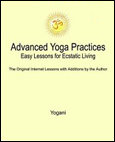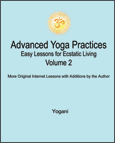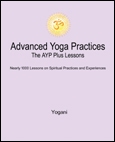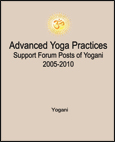|
Public Home | Plus Home | Main Lessons | Tantra Lessons | Public Forum | Plus Forum | Downloads | Books Topic Paths | Search | Training-Retreats | Testimonials | Survey | Interviews | MultiMedia | Contact | Donate |
|
Advanced Yoga Practices Note: For the Original Internet Lessons with additions, see the AYP Easy Lessons Books. For the Expanded and Interactive Internet Lessons, AYP Online Books, Audiobooks and more, see AYP Plus. Lesson 323 - Roles of Knowledge, Philosophy and Direct Experience (Audio)
AYP Plus
Additions:
From: Yogani New Visitors: It is recommended you read from the beginning of the web archive, as previous lessons are prerequisite to this one. The first lesson is, "Why This Discussion?"
"Who am I?" "What am I doing here?" "Who or what is God?" "What is the real nature of things?" "Is what I am experiencing right now really true?" And so on... If we ask our questions with feeling and persistence, if we continue to inquire, the answers will come to us sooner or later. How we go about it will determine our rate of progress, and the degree of ease or difficulty we may experience on the road to knowledge. Therefore, a methodology with predictable results can bring some important benefits. We will attempt to deliver a reliable approach to the field of self-inquiry in these lessons. Please bear with it for a few more lessons, and it will begin to come together. Achieving a measure of "reliability" in the field of self-inquiry is a novel idea, because the traditional approaches to self-inquiry are often accompanied by much uncertainty, for reasons that will become clear as we move along. Is such uncertainty necessary? Not really. It is only a matter of gaining some education and understanding of the dynamics of human spiritual transformation. With some practical perspective, the journey can be made without pulling the hinges off the divine doorway of our nervous system, or getting stuck in endless do-loops of mental machination. It is a paradox that formal structured approaches to self-inquiry can lead to uncertainty and limited results. If finding the truth were simply a matter of developing an intellectual understanding of the nature of reality, it would be easy as easy as taking a high school class in physics, including an introduction to the principles of quantum mechanics. With that, we will know that all we see and do in life is playing out in a vast realm of absolute emptiness, with innumerable bits of interacting energy creating the appearance and substance of everything we consider to be our real world. How real is this world we perceive through our senses if all we are seeing, hearing and touching is nothing but energy interacting with itself in vast emptiness? This is a question that cannot be avoided when considering the ultimate implications of quantum mechanics, or of our life in this world. Why is there an apparent inconsistency between what physics tells us and the physical world we perceive around us? And how does this inconsistency affect the quality of our life? Can knowing the truth about this alleviate our suffering, as wise people both ancient and modern have promised? We can find out for ourselves through direct experience. It is a matter of perception. To experience and know more, our perception must be refined. While we cannot perceive radio waves with our normal senses, we have developed the technology to perceive them, and use them for great benefit. Modern science has opened many doors for us in this way. Interestingly, the ancient science of yoga goes quite a lot further than modern science has so far in dealing with the unseen realm of absolute emptiness we are purported to be made of and living in. While modern science relies on devices enabling us to perceive and utilize principles in nature that we cannot see, the field of yoga relies on the human nervous system to do the same thing, and with remarkable results. While utilizing our own nervous system as the primary instrument for discerning and applying the ultimate truth of life may seem like a new idea, there have been small groups of people doing it for thousands of years. The great religions of the world have spun off and grown from these spiritual innovators. Now we find ourselves in the information age, where knowledge can be more easily distilled, preserved and shared among many. Modern information technology has come to lend a hand to the ancient science of spirit. Due to the rapid rise of knowledge, we have arrived at a turning point, a point where many people around the world can deepen their inquiry about the nature of things, shifting the perspective from being outside ourselves to include a more penetrating inquiry from the point of view of what is inside us our radiant inner Self. This has been made possible by the rise of knowledge about integrated spiritual practices in the modern world, with the principles and methods of practical self-inquiry being part of that. Self-inquiry is not new. It has been part of yoga and other systems of spiritual practice for centuries. It has been called jnana yoga, meaning "union through knowledge." That is, union of the inner and outer aspects of life. Self-inquiry has also been called the path of discrimination, and the path of the intellect. Knowledge of what? Discrimination of what? Intellectual knowledge of what? These are fair questions. Jnana also means wisdom, which points to a deeper level of knowing, a spiritual knowing, where the questions and answers become merged as One, which is the end game of self-inquiry, and all of yoga. In upcoming lessons we will delve into the particulars of self-inquiry, and additional yoga practices upon which its success depends. But first, let's look at the relationship of philosophy and experience, which can help form a framework and basis for a practical approach to self-inquiry. It is a starting point. As we begin to think about the true nature of things, it is helpful to have a foundation in the form of an idea or structure. Or, better yet, an ideal. Quantum physics was mentioned for this reason, offering the modern scientific model of emptiness underlying our physical universe. The ancient philosophical traditions of the East concur with this view, with an additional component added the presence of consciousness in absolute emptiness and emerging from it. While it may not be possible to verify that the emptiness underlying everything is conscious, we can certainly verify that what manifests from emptiness is conscious, because we are conscious. Ancient eastern philosophy, and some western philosophies also, hold emptiness to be the Great Self of all, and that all individual selves are but rays emanating from the One Great Self, much the way waves dance upon the surface of the ocean, only to dissolve and reappear on the surface of the ocean again and again. The waves are ever-changing expressions of the great ocean they dance upon. Whether the great ocean of emptiness beyond the manifested universe is conscious can be debated. But there can be little debate about whether human beings are conscious. It is this singular fact that underlies the entire field of self-inquiry. There is a vast theoretical body of knowledge, which can be found in the amply documented philosophies of both the East and the West, plus the experiential component of consciousness which can be found in every human being. Put these two together, and you have the beginnings of self-inquiry. It is really quite simple. If we can come to know that we are, in fact, the ocean before, during and after we are the wave, then the inquiry is done. Enlightenment is ours. Philosophically, that is called the end of knowledge. In the East, it is called Vedanta the end of the Veda, or the end of knowledge. But, experientially, it is not so simple. Something more is needed, which is often overlooked by those who hold an uncompromising view of human enlightenment. If our own experience does not fulfill the philosophy, or even what another may claim as their experience, then the inquiry is not complete. While purists may hold that emptiness permeates everything and that we are living in a "non-dual" existence rather than the apparent "dual" one, then it is up to each of us to verify the truth of this for ourselves. Then we will know. Until then, we should take no ones word for it. It is for this that the methods of self-inquiry are given. But it turns out that self-inquiry by itself is a moving target, varying greatly in result depending on the person who is doing it. Just as certain ideas will resonate with some people and not others, the methods of self-inquiry may resonate with some practitioners and not with others. The reason for this variation is due to the inner condition of each individual nervous system. The nature and degree of inner purification and opening deep inside us has a direct bearing on the degree of consciousness that is available for gaining direct experiential knowledge of the nature of existence. The key factor in this is the presence of what we call "inner silence," also called pure bliss consciousness, the Self, or the witness. It is called the witness because stillness in our awareness is our ground state and, once established, is capable of experiencing all thoughts, emotions and perceptions of our external world as objects outside its own unmoving awareness. The presence of the witness changes the complexion and effectiveness of all self-inquiry methods dramatically, and our perception of every day living also. Then, the self-inquiry that had been a moving target becomes steady, and the very knowledge we have been seeking is what we become. We were That all along, and the witness is That. There is the old saying that, what we are seeking is what is doing the seeking. Our inner awareness in the form of the witness is both the goal and the means for attaining it. The witness can be cultivated in human beings by engaging in self-inquiry. However, this is very difficult to do it using self-inquiry as the sole means. Ask anyone who has tried without using any other supporting practices. A much more effective way to cultivate the witness is with daily deep meditation (see Lesson 13). Once this kind of cultivation is occurring on an ongoing basis, then self-inquiry will have the ability to gain some real traction in our lives, and add far-reaching additional benefits that could not be realized with either deep meditation or self-inquiry alone. When we say "traction," we mean the formation of an intimate relationship between our native consciousness and the objects of this world, including our thoughts, feelings and perceptions of the external environment. Our abiding inner witness, combined with self-inquiry, can lead us steadily toward a condition of Oneness, beyond the ups and downs of life, even as we are fully engaged and going about our business each day. In this condition, there is no grasping or hanging on. So, if we are looking for real self-inquiry, we should look beyond the dictums of rigid philosophical systems to the inner workings of our own nervous system. If we do that, we will go beyond ideas to the experience itself. Then the wave will know itself to be the ocean, even as it continues as a wave. Philosophy is therefore not an end, but a beginning, a stepping stone to the greatest knowledge, which is the ongoing direct experience of our true nature our eternal Self, divine radiance, unbounded awareness, bliss consciousness, emptiness, void, Tao, or whatever you would like to call it. Once you become it, you can give it any name you like. Some have called it Pure Joy. The guru is in you. Discuss this Lesson in the AYP Plus Support Forum Note: For detailed discussion on the practical implications of self-inquiry, jnana (knowledge) and advaita (non-duality), see the Self-Inquiry book and the Liberation book, and AYP Plus. |
|
|
|
Join the Mail List:
AYP Retreats
eBooks - PDF, EPUB
FREE eBooks with
SAVE with Bundled
|

























